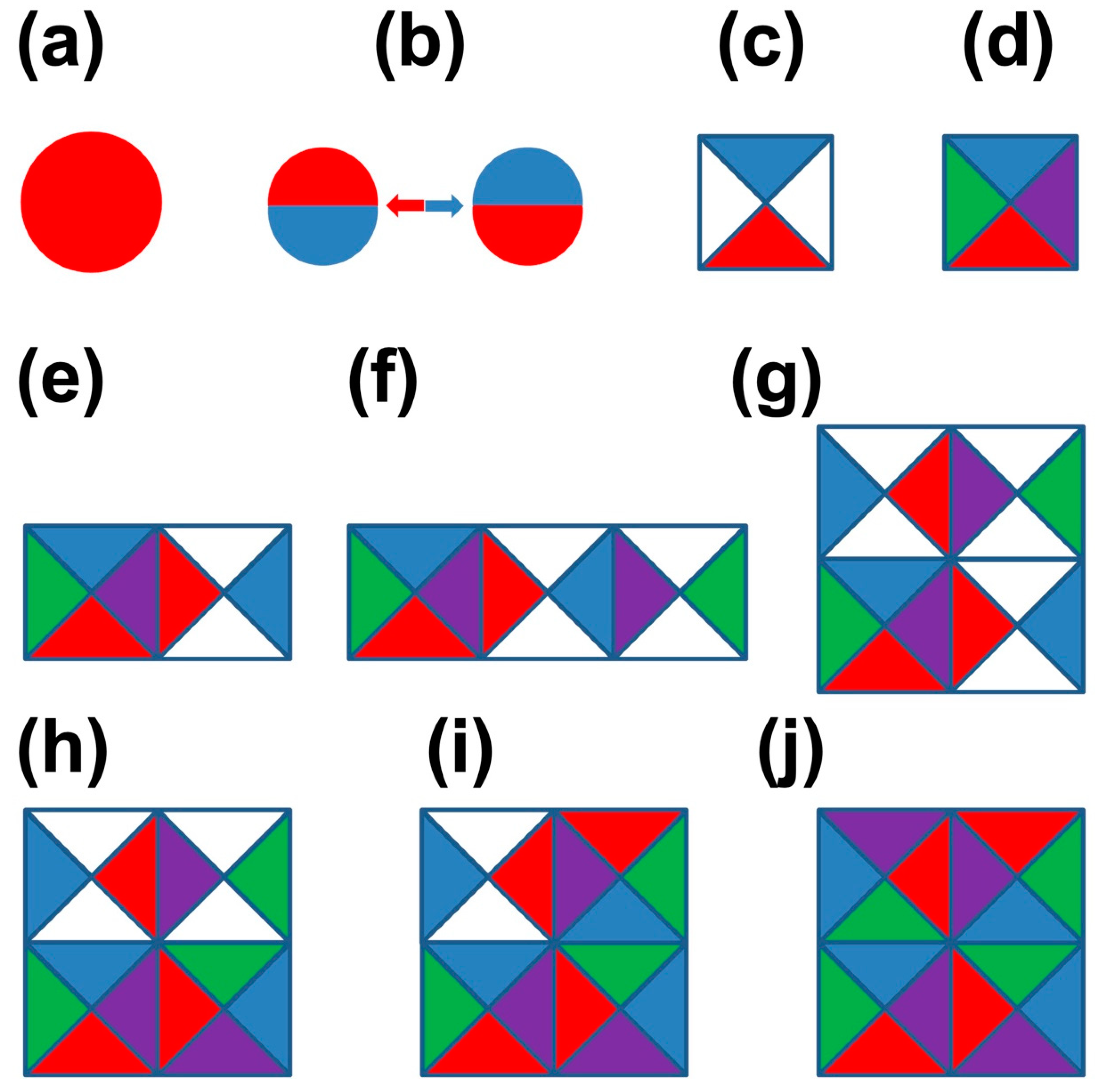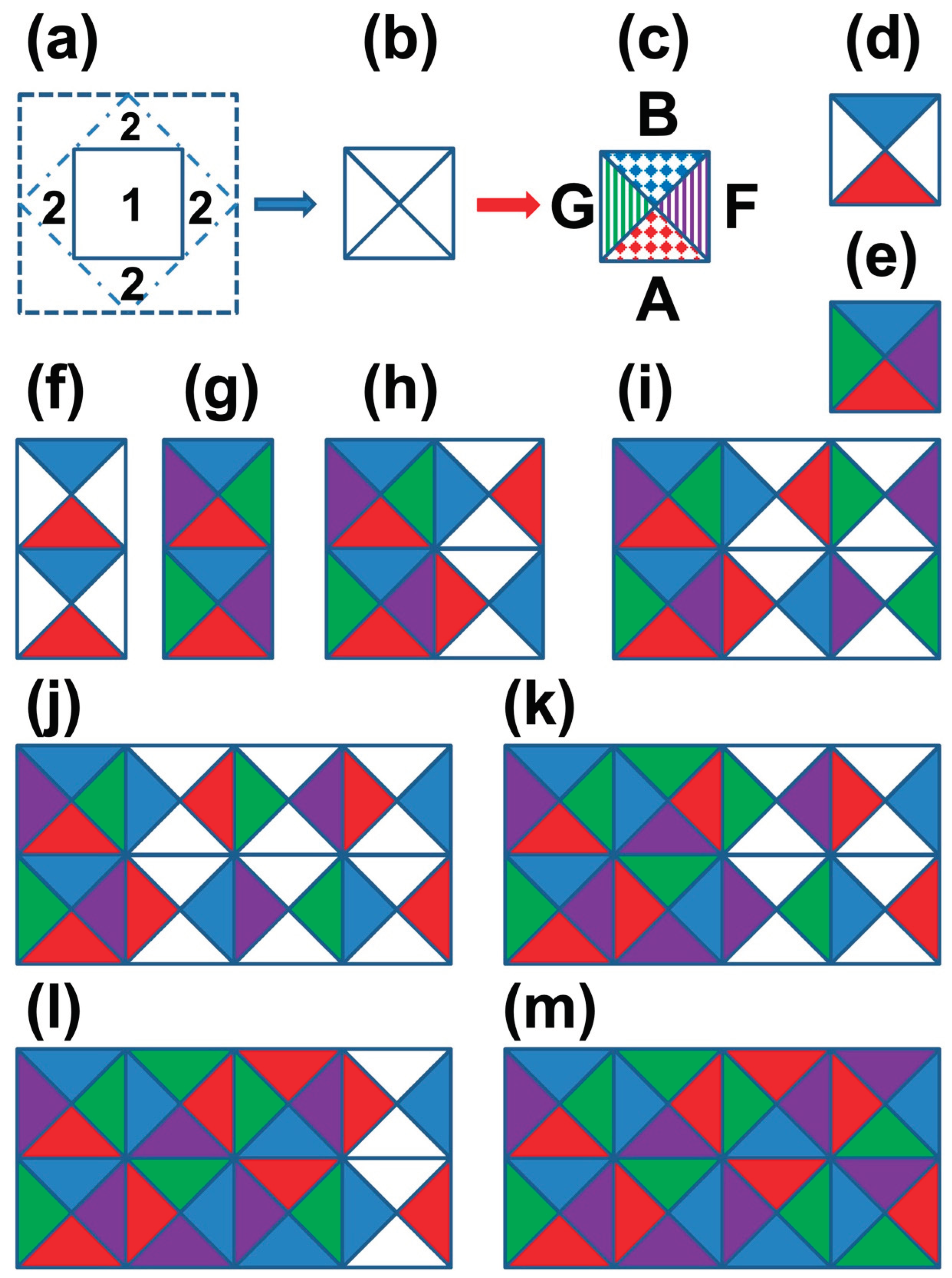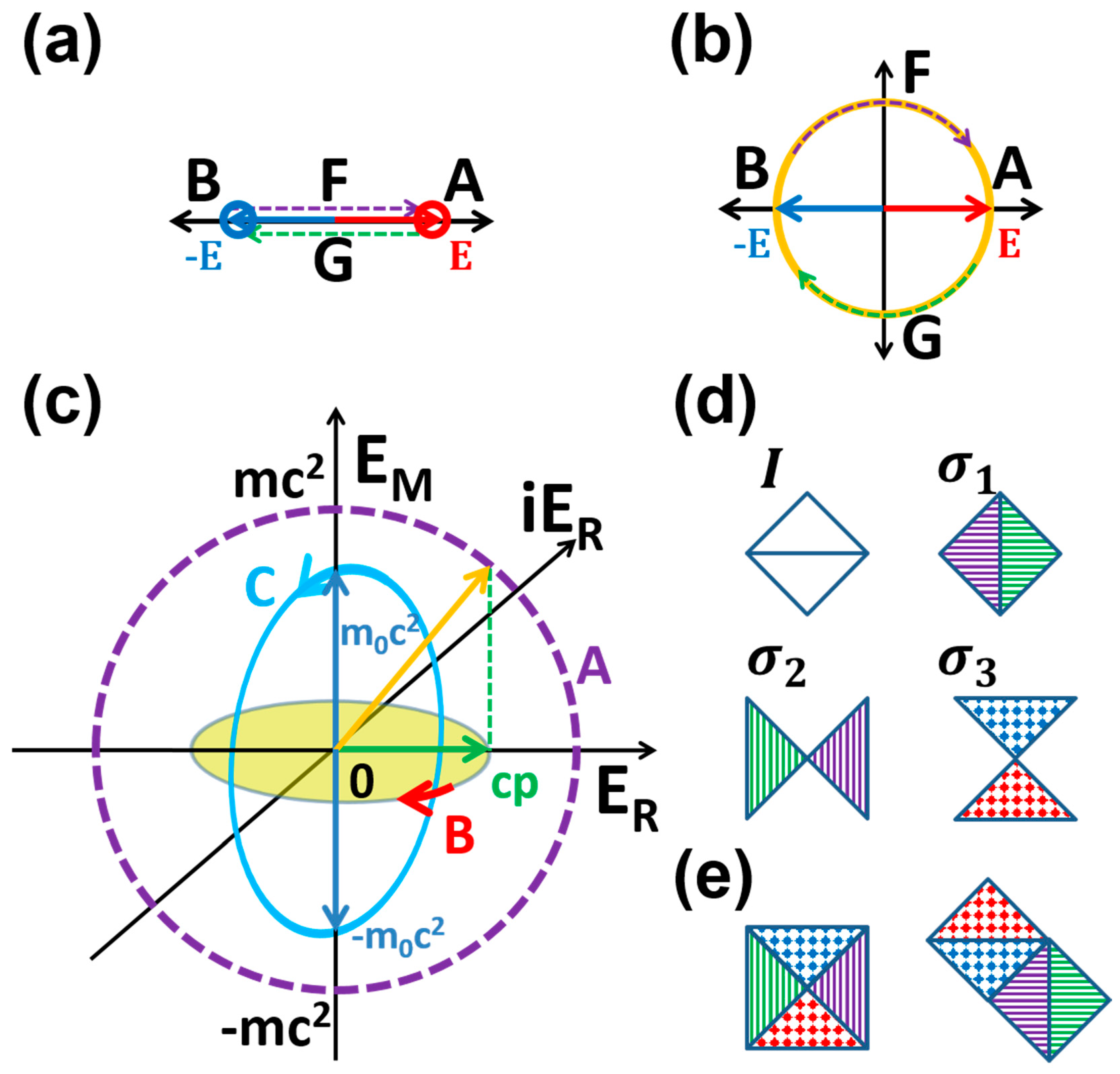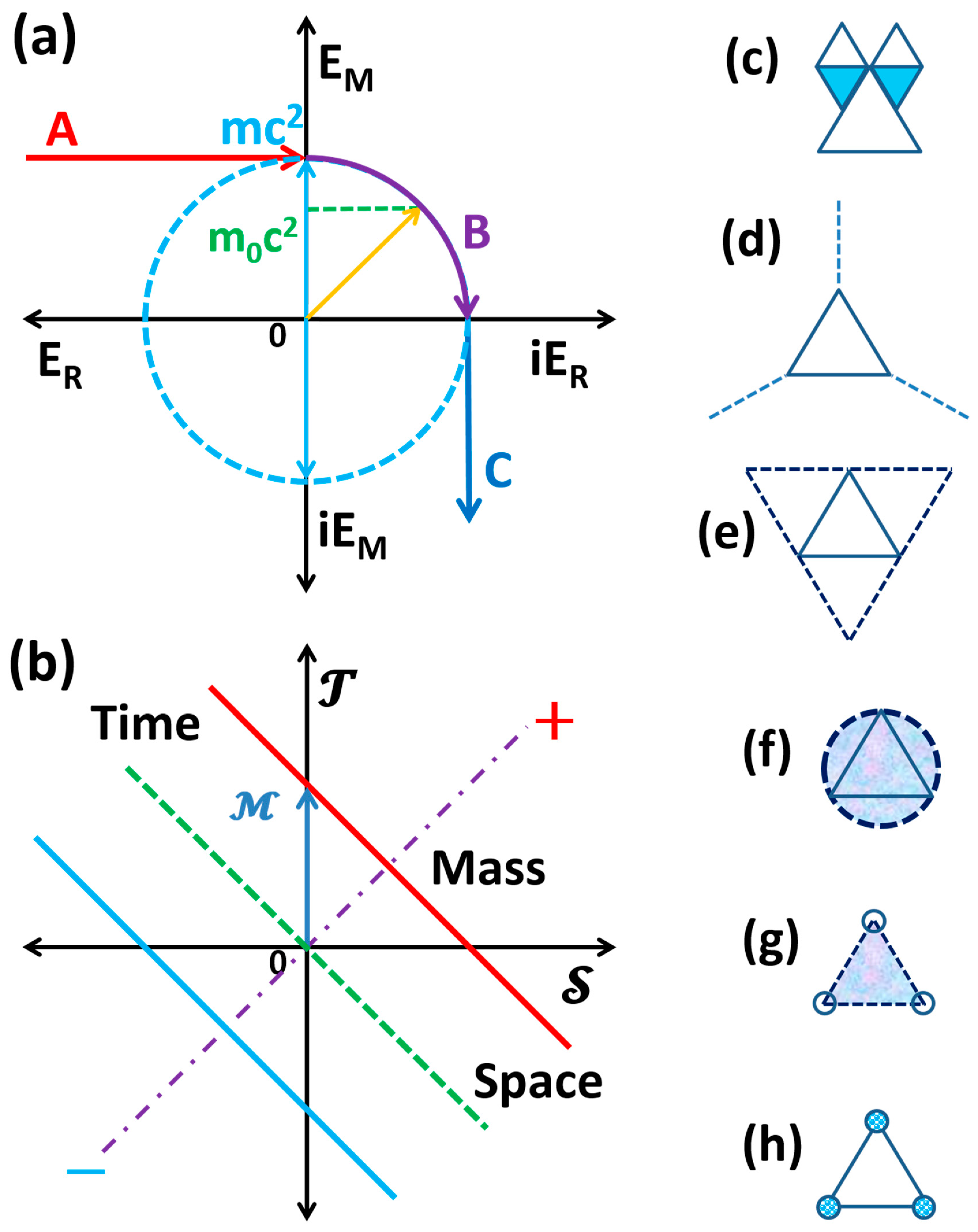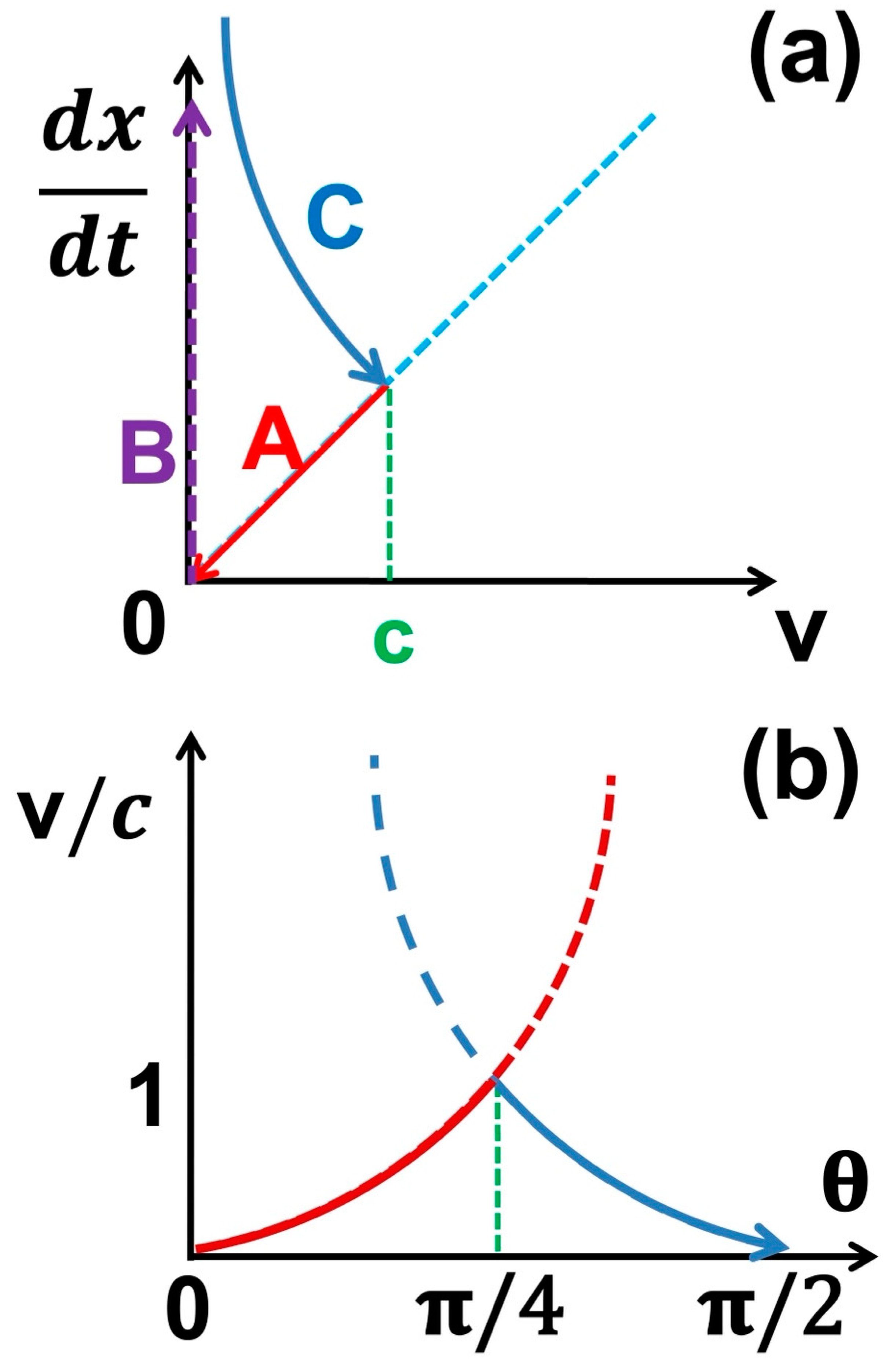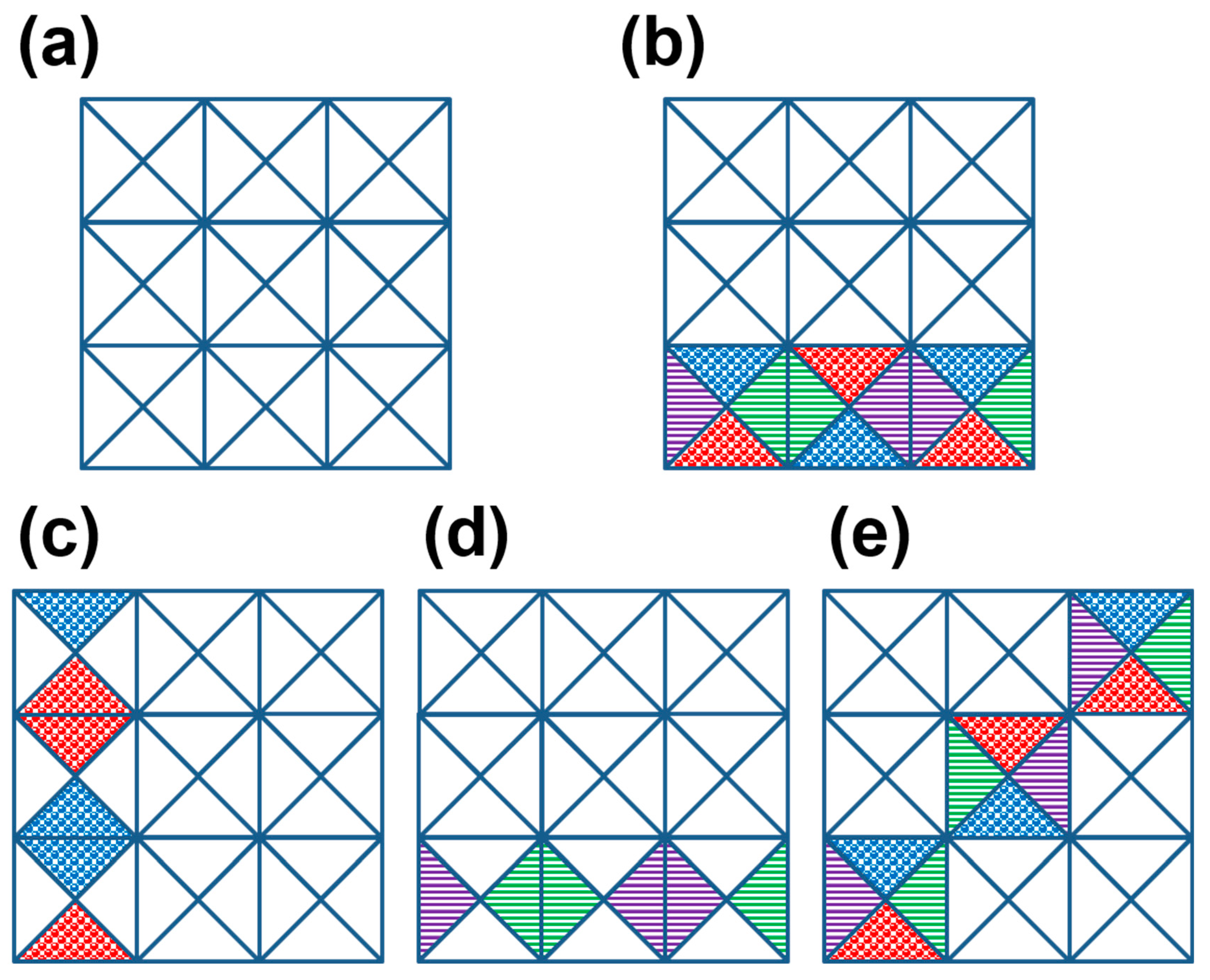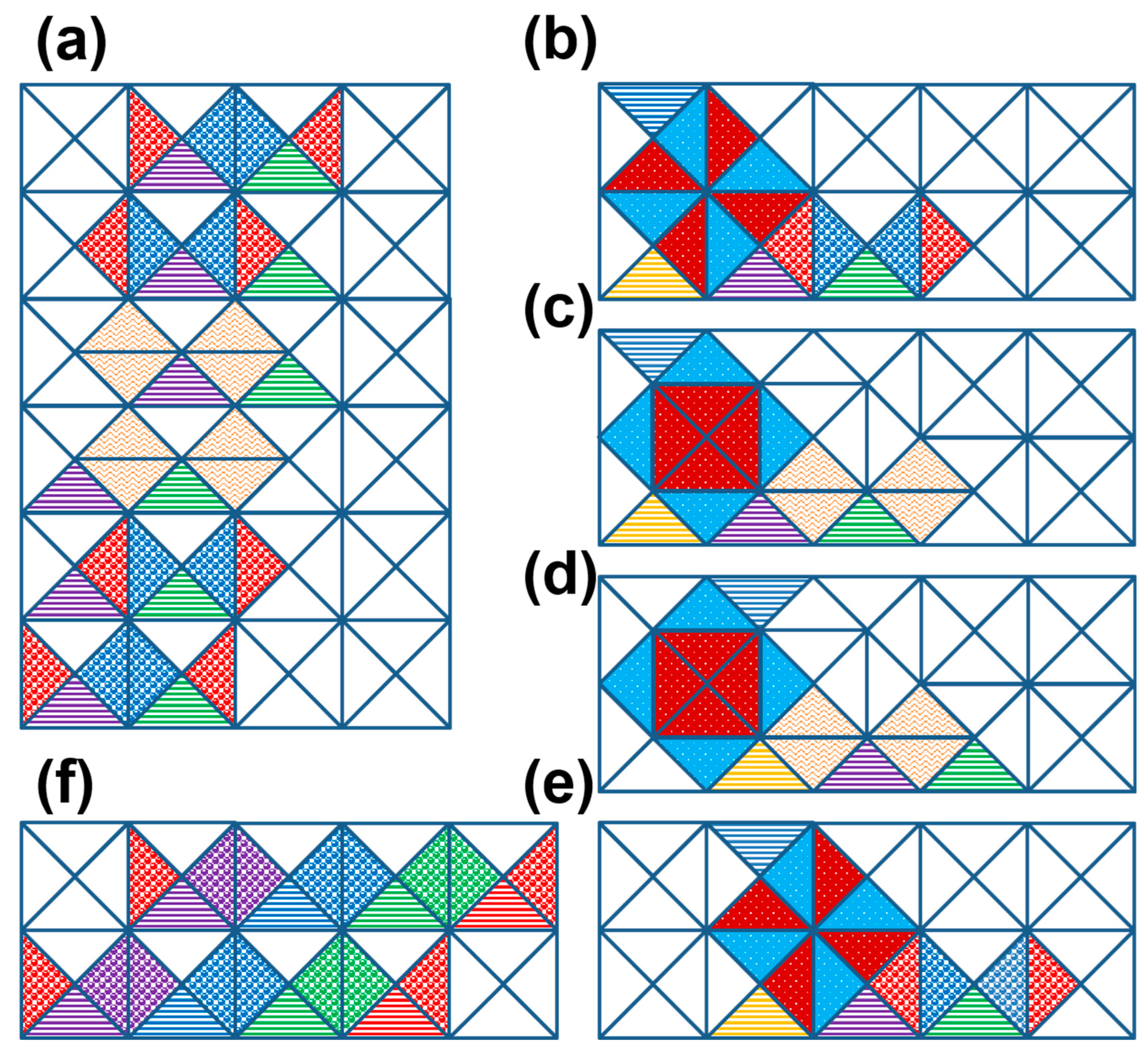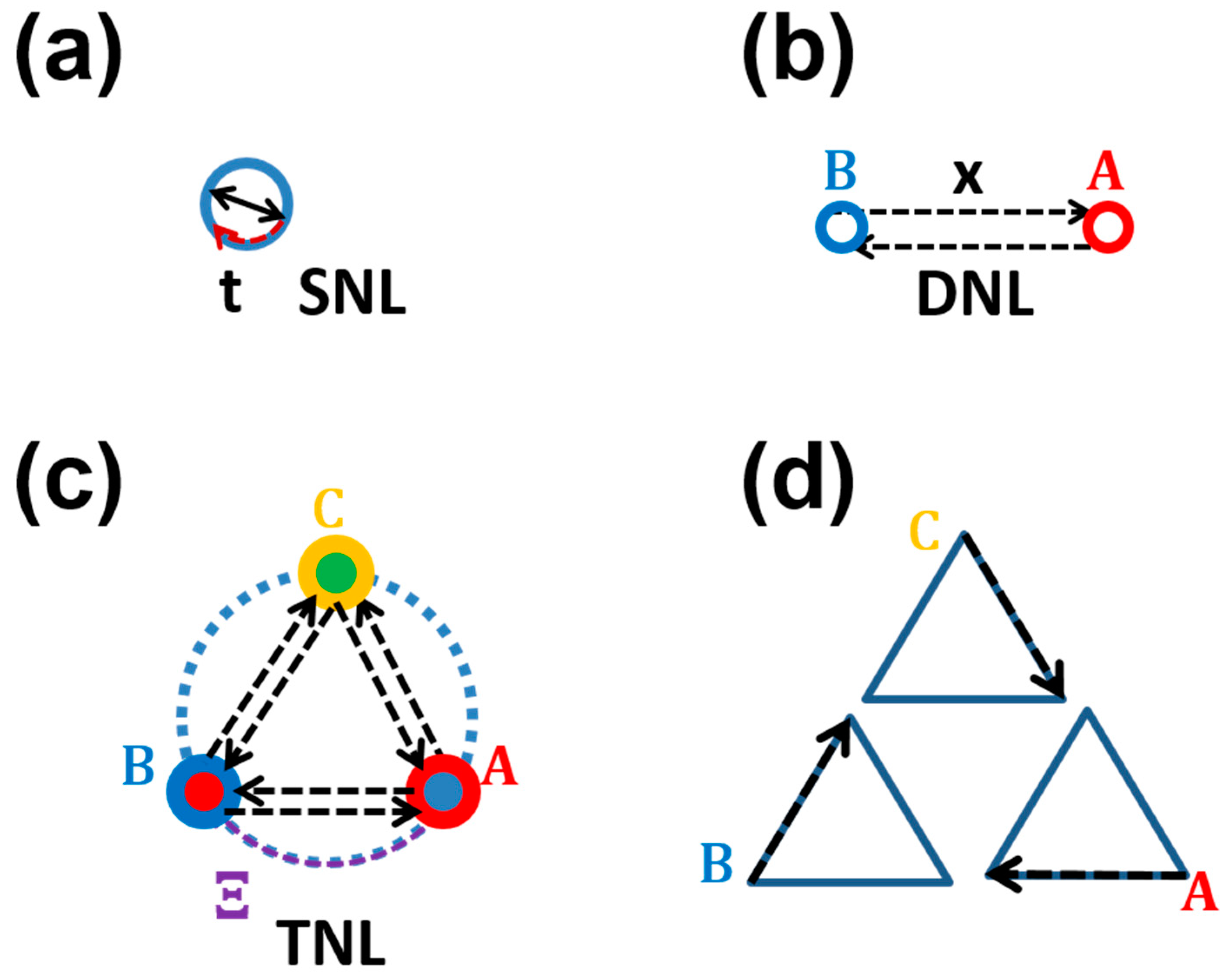2.1. Energy Space Decomposition
One of the most fundamental questions is what time and space come from? To provide a possible answer to it, let us start from a heuristic quantum representation of energy space. Energy is commonly taken as a universal scalar to quantify a system of interest and different forms of energy may transform among one another. Given the fact that in general, a system of interest can be described in terms of energy states as done in conventional quantum mechanics [
54,
55], the identification and classification of the energy basis (modules) and energy transformations in a framework of energy space would be of fundamental importance. Instead of classifying energy as a scalar according to the resources, or physical effects, we identify and construct the energy basis in a tensor form based on mathematical structures. Therefore, the resulting energy space is a tensor space rather than a Hilbert space comprising (scalar) energy eigenstates. In addition, there is neither predefined space-time nor ad hoc parameters (so there is no Hilbert space in prior) while we construct everything from the proposed most fundamental objects, or the corresponding mathematical identities, i.e., primitive energy basis.
Consider an isolated fundamental object with no internal structure; its property may be quantified in terms of the total energy E that remains constant. We could associate this fundamental object with the primitive unit based on which general objects may be constructed, just like the atom in the primitive atomic theory. Mathematically this object can be represented algebraically as an element (of a set), or geometrically a point (in a space). To quantify such a system, we can map it to a zero-order tensor, i.e., a scalar. A set of scalars may form a scalar space (i.e., a zero-order tensor space) which can be used to quantify a composite system consisting of multiple non-interacting primitive objects. In the simplest example of a system including identical non-interacting primitive objects, we can assign the unity 1 (in terms of energy E) for each primitive object (versus 0 for nothing). Therefore, we indeed have a scalar energy space with the basis mapped to an energy quantum or energy atom (see
Appendix A for further discussions). Of course, for a system containing more than one objects, the relation between different objects, i.e., interactions or transformations, would be interesting. In the mathematical model, if we take the objects as elements, their relations thus can be represented in terms of tensors formed by a set of elements. For instance, the interactions (or transformations) of two scalars may be represented by vectors; and similarly, the relations of vectors may be described by matrices, and so on. Therefore, we can construct vector space (or tensor space) to quantify complicated systems involving nontrivial interactions. Geometrically if we represent the elements as points, and their relations as lines connecting different points, we end up with a net representation.
Consider the relation between two types of elements A and B, one class of relationship could be they transform into each other directly. Assuming that A and B have identical characteristic values in metric energy, i.e. E(A)=E(B), the transformations
and
are energy conserved. Here we define the metric of the energy space to be
with
the energy (tensor) of the element X in a general sense, and
denotes the inner product [
56]. For instance, the metric energy of the zero-order tensor is its absolute value; that of the first order tensor is the magnitude of the energy vector, and that of the second order tensor can be defined as the square root of the trace of the inner product of the energy matrix.
For simplicity, we start from considering the scalar case such that
, representing for a symmetric pair of elements A and B with opposite scalar energy values. To quantify this system beyond the scalar representation, the interactions between A and B are represented by vectors F and G connecting two scalars. Thus, the one-dimensional (1D) energy space is generated upon the introduction of the interactions. Specifically, the system can be mapped to 1D Euclidean space, and the two elements correspond to the ending points of the segment of [–1, 1], while their relations correspond to the connecting lines in-between, as shown in
Figure 1a as the net representation of the system. Here we may map the discrete transformation in
Figure 1a to a Z
2 group, say an inversion group I = {e, i}, while the transformations F and G are not unique. Alternatively, we may follow a unitary transformation via intermediate states (continuous transformation may result as the number of intermediate states approaches infinity) satisfying energy conservation, as shown in
Figure 1b. In the latter case, the original space is expanded if we consider the intermediate states along the transformation path as new elements. Indeed, the energy space may be mapped to a two dimensional (2D) Euclidean space or complex plane, and the two extremes on the imaginary axis may be taken as new basis (element) identified with intermediate bosons. It is worth noting that this type of transformation allows the conversion of different types of energy basis.
One way to understand the interaction induced difference between A and B is that they are the effective (or renormalized) elements for two original objects A0 and B0 with different values of energy, say
and
. In fact, it is easy to see that
, with
. When
, it is reduced to the scalar case. While when
, we arrive at the case just considered with the maximal energy fluctuation for a given energy. On the other hand, we may regard the difference between A and B coming from the sign (phase rather than magnitude) of the energy. Thus, the interaction between A and B can be represented by the internal energy transformation associated with the orientation of the energy vector connecting A and B as a whole. Again, if intermediate states are allowed, they can be mapped to the surface of sphere in the high dimensional space. Nevertheless, it seems that only for the 2D energy space (
Figure 1b), well defined order for all the states can be identified, i.e., clockwise and counterclockwise. In another word, a 2D energy space with magnitude E and phase
as the polar coordinates allows for uniquely defined global order among all involved states while maintains unitary energy transformation.
To obtain a quantitative description, we may construct a 2D vector space with the basis and representing for A and B respectively. Therefore, the transformations F and G may be represented in terms of matrices, e.g., and . It is easy to see that and . If we associate A, B with FG and GF, respectively, these transformations form a four-dimensional (4D) state space . This scheme just expands the dimensionality of the state space from 2 to 4, and therefore treats both the primitive elements and transformations in the 2D space at an equal footing as new basis in the 4D state space. Note that here the expanded state space is a generalized state space. One may ask if such a generalization could be related with the symmetry of the state space structure. However, the set of () does not form a group.
Of course, this basis is not unique, and other types of basis may be constructed. Our strategy in the present work is to start from primitive energy elements and systematically construct energy modules (or molecules) of higher levels to form a hierarchical structure of energy space. This is just like to synthesize materials bottom-up from atoms to molecules and other higher-level structures. On the other hand, this construction allows representing the system of interest in the decomposed MES top-down to deeper hierarchies.
To elaborate our idea, consider again the above two-state system. Here we suggest an alternative simple mapping scheme. For instance, A and B could be identified with elements in the energy space specified in terms of a particular degree of freedom (DOF), say spin (not necessary to be the charge spin) so that S(A)=1 and S(B)=-1. For example, S could be the projection operator, which quantifies A and B with the coordinates of 1 and -1, respectively. While the coordinates of F and G may be taken as i and –i, respectively upon the projection of S. Now we see that the set of S(A), S(B), S(F), and S(G) forms a group isomorphic to the group of Z4, which can be mapped to the four basis in the complex plane as we just mentioned.
Specifically, a second order basis may be constructed by the direct sum of the primitive basis
and
, i.e.
Here the operator S can be taken as the identity
matrix. The continuous transformation of the A and B states may be captured by forming a basis using exponential functions, i.e.
As the angle variable
varies from 0 to
, the system transforms from state A to states F, B, and G, respectively. The generalization of coordinates (of the elements) from real to complex plane introduces F and G as energy elements and allows the energy transformation to be continuous (or performed in a closed connected space,
Figure 1b).
Alternative basis equivalent to Eq. 2 can be straightforwardly constructed. For instance, we can take
Here the
are the three Pauli matrices, and other elements F, B, G are given by the same relation as in Eq. 2. It is easy to see that the basis in Eq. 2 and Eq. 3 can form a larger group of
(
), and the basis in Eq. 3 may be generated from that in Eq. 2 by a unitary transformation. This scheme can be generalized to higher dimensional systems. For instance, the higher order basis may be constructed by the direct sum of the basis A and B, and the dimension of the base space is thus expanded from 2 to 4 (see
Appendix A for details).
The primitive energy basis could be chosen as energy eigenstates of the system Hamiltonian, which can be mapped to the basis functions, e.g.
. The corresponding primitive pair basis can be written by, i.e.
If the primitive basis is mapped to the two elements A and B in
Figure 1b, then the single primitive pair basis can be mapped to the vector
, just like a rod with two ends, or a chemical bond with two atoms. The same four-state space mentioned above may be represented in terms of this primitive pair basis, e.g.,
. Note that the resulting space is not the energy space directly formed by primitive energy atoms, but a function (energy) space formed by function basis, which can represent the symmetry of the relation (or transformation) of the system (structure).
Other construction schemes based on primitive pair states exist for high order energy basis. One possibility is to use the linear combination of the primitive basis of the four-state system [
53], i.e.
This scalar representation can be mapped to the vector form in terms of the primitive pair basis, i.e.
Physically, the two bases in Eq. 5a may be mapped to the bonding and anti-bonding states of the energy modules of two primitive energy elements, while the two bases in Eq.5b correspond to the radiation states associated with the bond formation/breakage. These four bases span the same 4D state space
. In the same spirit, another equivalent basis may be given by
Since this composite basis is the unitary transformation of the primitive energy elements, and it is well-known that continuous transformation may be generated by three Pauli matrices as generators, we associate the three generators of Pauli matrices with different types of energy transformation and energy modules. The three types of unitary transformation generated by the Pauli matrices are [
57]:
It is easy to see that the set of basis in Eq. 1 and 2 correspond to the transformations
, respectively. And the transformation
generates the third type of basis, i.e.
These are the energy modules used in our previous work [
53] to represent the solution of Schrödinger Equation for a four-state system.
Energy transformation among the energy modules may be quantified, for example, by the unitary transformations in Eq. 7, which correspond to the rotation in energy space along a specific axis determined by the three Pauli matrices (
Figure 1c). As a result, the energy space can be decomposed in three-dimensional (3D) space with each isosurface of total energy as a Bloch sphere. The three Pauli matrices, together with the identity transformation I, constitute generators of unitary group U(2), which are widely applied in quantum mechanics to quantify the symmetry of the system [
58,
59]. Nevertheless, the same symmetry or the same math may be interpreted in dramatically different ways. Then the question is how we choose what these abstract mathematical elements and corresponding transformations are responsible for? Or what is the mapping between this mathematical structure and the realistic system of interest?
The mapping we focus on in this work is between the energy elements (and their transformations) and the elementary structure (and dynamics) of our world. We may start from identifying the three energy pair states dictated by the three Pauli matrices with different forms of fundamental energy modules, and we name them as shion, kongon and yunon [
60], respectively. Together with the pair state associated with the identity matrix in Eq. 2 (we name it as benon), we obtain a group of generators of energy elements. These energy modules (Eq. 3, see
Figure 1d for a 2D representation) constructed from the direct sum of the first order primitive energy basis (or energy elements), are associated with four types of elementary energy transformation (EET).
Our main postulation in this work is that energy fluctuation and transformation may be represented in terms of primitive energy basis (may be further identified with matter and radiation state), which can be associated with EET that generates time, space, cloud (see below), or other types of (higher level) structures. The model also maps quantum dynamics (motion in space-time) in energy space in terms of EET, with the space-time evolution of the system of interest represented by energy transformation among different energy modules. Combining the fundamental energy modules and elementary energy transformations, we construct a modular energy space (MES) as a framework to quantify or represent our world. In another word, the world can be generated from energy modules and energy transformations, in the same way as generating crystals from unit cells (see
Figure 1e for representative energy cells) and symmetry transformation. Note that in our modular framework of energy transformation, time and space are quantized as the corresponding energy basis is quantized. In addition, there is no predefined spacetime or coordinates. One may create mathematical framework such as vector space to quantify the system, and even define nontrivial operation rules such as derivatives to describe spacetime transformations. Interactions (in particular the gravity) can be associated with coordinates based geometric objects such as curvature and connection [
3,
13,
19,
61]. However, geometrization based on nontrivial operation of simple basis is not the only way to quantify complex interactions. In fact, MES introduces hierarchical basis (energy modules) which may simplify the operation rules for high level interactions. This strategy also goes beyond the measurement description on the interactions in relative state or relational quantum mechanics [
62,
63].
The classification of energy modules in our mapping scheme not only results in a well-organized MES but also maps abstract energy basis to physical objects, thus provides quantitative descriptions of the structure, properties and transformations of the system of interest as what a conventional wave function can do. In another word, the wave function of the system may be represented in terms of its projection on energy modules in MES, which however has a well-defined deterministic interpretation in contrast to the conventional statistical interpretation. In addition, the evolution of the wave function can be characterized by the phase of the energy or the effective angle of the vector (and object) in MES. This is reminiscent of the de Broglie-Madelung-Bohm representation of the wave function of action angle variables, i.e.
And the amplitude A is associated with the probability density, which is responsible for quantum potential [
6,
7] causing quantum deviations from the classical dynamics. Note that the action may be represented by the integral of a generalized Lagrangian, i.e.
Here q is generalized coordinate, (e.g., x or t), is the generalized velocity, and is the affine parameter which characterizes the integration path. If we take , then Eq. 10 reduces to the action of the conventional Lagrangian .
In contrast, the wave function in MES takes a new form in terms of action represented in the decomposed energy space, i.e.
which can be further expanded into a series:
To interpret the physical meaning of the proposed wave function, considering the case there is only the first term, which represents for the scalar contribution to the action, i.e.
the corresponding wave function given by Eq. 11a reads:
Here
is the scalar Lagrangian,
is the generalized energy and
is reference energy, i.e., the constant energy of a fundamental unit (e.g., energy atom). Assuming that a quantum mechanical system can be described by a wave function in the form of Eq. 11a-d, the time evolution of the system satisfies the first order ordinary differential equation (ODE) for a scalar energy state, i.e.
Here it is clear that explicit time dependence comes from the scalar energy fluctuation with respect to the reference (stationary) state, while the reference state may have internal time if it is multicomponent (see Appendix). In terms of internal time
, time dependent Schrödinger equation for the reference state reads.
In particular, when
, which means there is no additional DOF other than the internal DOFs, the explicit time coincides with the internal time
. On the other hand, the stationary state (eigenstate) is obtained when there is no energy fluctuation (
), i.e.,
with the eigenvalue of
. This corresponds to the case that internal DOFs are responsible for all the contributions to the generalized energy. These two cases represent for the two perspectives (interpretations) to the energy of the system, which may help illustrate the foundation of timeless quantum mechanics [
62,
64].
The single state case in Eq. 11c can be straightforwardly generalized to a multistate system, and the corresponding multistate quantum dynamics equation for an n-state system reads:
with
the n-component wave function,
the corresponding generalized Hamiltonian represented by a
matrix, and
I the identity matrix. Eq. 11h can be solved routinely by diagonalizing the Hamiltonian matrix resulting in a representation (vector) space spanned by energy eigenstates [
54]. It implies that unless all states are degenerated, explicit time dependence exists for multistate (n>1) systems. In addition, the hierarchical decomposition of the action (Eq. 11b) suggests that external and global time may be registered in a different hierarchy from the one where the system of interest is. Our model does not rely on the concept of position and the probability, and therefore seems to have no “problem of time” [
10]. Note that the integral in the definition of action may be reduced to a discretized sum if only a quantum clock is available.
What is new here in Eq. 11a is that we represent the action and the corresponding Lagrangian (e.g., Eq. 11c-d) in the energy space in terms of a generalized Hamiltonian in the tensor form, rather than in the conventional space-time or momentum space. Specifically, we associate the n-th order action
with a generalized Hamiltonian tensor
corresponding to the contribution from the n-body (energy module) interactions, which can be further decomposed into the sum of irreducible tensors of rank l:
As an example, let us explain our mapping scheme by considering a two-state system. The action is now decomposed into two terms corresponding to the contributions from the time integral of the scalar and vector energy (tensors), respectively, i.e.
To illustrate explicitly the mathematical structure of the energy space, a matrix representation is used in the last step of Eq. 12b (see
Appendix A for details). The first term represents for the scalar transformation of the energy space discussed in Eq. 11. Here let us focus on the second term. As shown in the construction of energy modules, the vector transformation of energy modules can be represented by the generators of SU(2) group, i.e. the three Pauli matrices, which may be mapped to the three components of the irreducible spherical tensor of rank 1, different from the zeroth rank scalar tensor. Physically, these three types of vector transformation correspond to the rotations in the energy space shown in
Figure 1a-c, in the 1, 2 and 3 dimensional space, respectively. And if we denote the two body inter-module energy transform rate as c, which is a constant in the free space, i.e., without higher order interactions, then the action can be rewritten into
Here we define the vector , and given by the ratio of the characteristic length and time of energy modules.
Similarly, the tensor expansion of action for a three-state system results in the form of integrals of various types:
where
, and
. Thus, they represent for the contribution of multipole terms of scalar, vector, and second order tensor (matrix), respectively, which again may be mapped to different types of energy transformation in MES. Higher order terms could be included explicitly; otherwise, we might be able to regard Eq.12d as a period of three loop, and represent higher order terms by using the same energy modules renormalized at different levels.
The tensor expansion of the generalized action in Eq. 12 suggests that the scalar fluctuation of action generates (scalar) energy (shion, or scalar mass state), and the corresponding scalar energy transformation creates time. Similarly, the vector fluctuation of action generates momentum (kongon, or radiation state), and vector energy (radiation) transformation creates space; the matrix fluctuation of action generates mass, and matrix energy transformation creates cloud (see
Figure 2). This mapping scheme may be extended to higher-level expansions, which corresponds to the generation of higher dimensional space. Here our model implies that there may exist different levels of expansion: for the first level, there exist only scalar module; for the second level, there are both scalar and vector modules; and for the third level, there exist scalar, vector and matrix (second order tensor) modules, and so on. This seems exactly the same rule followed by chemical elements to fill in the periodic table. And it is the set of quantum numbers to determine the energy levels. Therefore, we propose that energy elements follow the same filling rule. For instance, the principal quantum number determines the level, and the angular momentum quantum number determines the sublevel, i.e., l=0 (scalar), l=1(vector), and l=2(matrix). (See
Appendix A for further details). Correspondingly it suggests that there exist different levels (hierarchies) of worlds or universes, i.e., scalar energy (time) world, vector energy (time space) world, and matrix energy (e.g., time-space-cloud) world, etc.
To make the connection with conventional quantum dynamics, we consider a simple particle moving in 1D space with a constant momentum, and rewrite the three matrix expansion terms of action in Eq. 12d in an equivalent form in terms of the generators of energy transformation using Pauli matrices, i.e.
which are mapped to the contributions to the action from the energy modules of shion, kongon and yunon in MES, respectively. Note that the last term may be combined with the first two terms resulting in a renormalized space-time. Then Eq. 11 can be reduced to the conventional wave function
. In addition, Eq. 13 may be mapped to a two-state system resulting in the Klein Gordon Equation. On the other hand, Eq. 11-13 can be straightforwardly generalized to the more complicated cases, through a variety of ways including dimensional expansion and time discretization. For instance, the wave function for a system of two two-state particles (four-state) may be obtained from Eq. 11 using a Hamiltonian expanded in
matrices and a time discretized form may be given by:
The corresponding wave function apparently satisfies the Schrödinger equation.
Note that the wave function in Eq. 11 represents for the single trajectory in the energy space, and the ensemble of trajectories may be used for a collection of particles exactly like applying statistical mechanics based on classical trajectories for complex systems. And the initial condition of the ensemble is thus given by
, which is the wave function at time 0, with the coordinates
(projections on energy modules). This is in contrast to the de Broglie-Madelung-Bohm representation in Eq. 9, which itself is a nonlocal wave function with a time dependent magnitude associated with the probability density (therefore the statistical interpretation has already built-in for the single trajectory). In addition, all the time dependent parts are incorporated into the exponential term in Eq. 11, which is in fact the time evolution operator with respect to a non-interacting hierarchical reference state if we write the action into the time integral of the corresponding Hamiltonian, i.e.
Therefore, it is not surprising that Eq. 11a indeed describes the time evolution of the system in the energy representation and satisfies Schrödinger Equation, which also bears the feature of the matrix representation as suggested in Heisenberg’s matrix mechanics [
54,
55].
To compare with the conventional definition of the action in Eq. 9, we write the action in Eq. 11 as
Here we generalize the first term in the conventional action into the energy tensor in energy space (c.f. Eq. 11 and 12) and identify the conventional (scalar) Hamiltonian as the total energy of the system. The system Hamiltonian matrix may be constructed from the energy tensor (see
Appendix A), and when applying the stationary phase condition (or equivalently the principle of least action), we obtain the Newton equation, i.e.
In addition, from the constructed wave function, the relativistic Klein-Gordon (or multistate Schrödinger) equation follows, i.e.
Note that our formalism implies that the unitary transformation with invariant time and space guarantees energy and momentum conservations, respectively, whereas that with invariant cloud guarantees mass conservation. In addition, this hierarchical world picture built on MES suggests a molecular interpretation to the renormalization in conventional quantum theory for fundamental particles and interactions (to be further investigated in future works).
2.2. Time Space Transformation
The equivalency of energy momentum relation in MES and space-time dynamics (both are related to each other through integral transformations) facilitates detailed analysis on the structure of energy space and stimulate new physical insights into energy transformation. For instance, energy transformation is apparently not necessary to be unimodular, described by the three Pauli matrices. In fact, any trajectory in the energy space may correspond to a particular energy transformation pathway, just as a trajectory in the phase space representing for a particular space-time transformation of the system of interest.
To illustrate the MES perspective on energy transformation, let us consider a free particle in 1D space. According to the wave function in terms of energy tensor expansion of action, the equation of motion (EOM) is a generalized Klein Gordon equation (Eq. 16):
and the solution may take the form of
with
are the wave vector and frequency, respectively. Following the pattern in the conventional form, the additional third term in the phase comprises
, the cloud area rate in the cloud (space), and the associated variable
, called the wave matrix. Here the energy relation (or energy representation of EOM in MES) reads:
As radiation energy (or k) decreases, a pure mass state may be obtained when all attached intermediate bosons leave away.
If the square of radiation energy further decreases (k becomes into imaginary, i.e.,
), we may have
Now radiation becomes internal and may be written into
with
being the coherence length of internal radiation, and the Compton wavelength
. Therefore Eq. 19 indicates that as the coherence length decreases to the Compton wavelength or the internal time
decreases to the characteristic time (or the effective velocity of the confined particle increases from zero to the speed of light), the mass state may turn into (or is balanced by) a coherence state in full. The resulting state can be associated with the MLNP, generated from mass state by approaching full quantum coherence (QC) in the internal limit.
Clearly, Eq. 18 and 19 represent for two classes of states: one is free wave and the other is confined wave corresponding to external and internal QC, respectively. They are involved in two typical routes (A and B) shown in
Figure 3a. At the point where the MLNP is generated, the original total energy of the particle decreases to zero. As the coherence length further decreases or the radiation energy further increases, the square of the total energy would become negative (route C in
Figure 3a,
). Then we have
Here to retain the positivity of energy square, we explicitly extract the negative sign out in Eq. 19b and 21b. After rearranging the order of terms, well-behaved energy relation recovers as shown in Table I. And this operation implies certain transformation may occur as the nature of pathways changes. Indeed,
Figure 3b illustrates transitions among different regimes in a generalized energy space via characteristic lines:
with
. Accordingly, the energy space is decomposed into the time-like, mass-like and space-like sectors. The time-like domain corresponds to the external world, and the space-like domain is associated with the internal world, in which the role of time and space shifts, i.e., the internal radiation behaves like shion whereas the internal mass state behaves like radiation. Interestingly external radiation pair state may generate vast space in the time-like domain whereas internal radiation pair state could generate various time loops in the spatial confined space-like domain. In comparison with energy transformation in the previous section, the pathways A and C here describe open systems while pathway B is for closed systems, the same as those captured by three Pauli matrices. Alternatively, we may regard the pathways A and C as physical transformations (magnitude changed) while those defined by Pauli matrices as chemical transformations (module changed).
Table 3.
a, in line with the corresponding wavefunction, D’Alembertian operator, and transformation angle
Table 3.
a, in line with the corresponding wavefunction, D’Alembertian operator, and transformation angle
| Route |
A (Time-like) |
B (Mass-like) |
C (Space-like) |
| Energy relation |
|
|
|
| Rearranged |
|
|
|
| states |
|
|
|
| Operator upon basis change |
|
|
|
|
0 |
|
|
From the time-like domain to the space-like domain (route A vs. route C), the mass energy term in the energy relation keeps invariant while the total energy changes from scalar (mass) energy to radiation energy, which implies that the role of two components switches, and correspondingly the role of time and space switches. From route A to B, the external time is substituted by the characteristic time associated with the rest mass, and the external world turns into an internal world. The role of time and space switches along route B in the mass-like domain as the connection between routes A and C. From route B to C internal radiation (with the feature of internal time) increases (
Figure 3c-h). If we define the spatial basis in the space-like domain to be ct, and the time to be x/c, then the energy relation (and physical laws) would be invariant.
To be specific, instead of transforming state variables, the basis transformation in route B may be obtained by the following mapping:
which gives the transformation of the line elements, i.e.
In the time-like domain (
), we have
; while in the space-like domain (
),
; and in the mass-like domain in between transformation between time and space occurs. Such basis transformation provides a new perspective different from analytical continuation of corresponding variables into complex plane [
65,
66,
67].
This timespace transformation (TT) may correspond to a quantum phase transition. The crossover behavior is illustrated in
Figure 4a. In the time-like domain (external world), the velocity decreases from c to zero, as external intermediate bosons being detached. The mass-like domain in the expanded energy space connecting both time-like and space-like domains in which the role of time and space is exchanged so that the rate dx/dt switches from zero to infinity. Note that for fixed
,
in Eq. 23b, and therefore
serves as the order parameter of phase transition (
Figure 4b). At
, time and space become degenerated, marking the transition point in the mass-like domain. In the space-like domain, if the confined internal intermediate bosons can be excited, the velocity could also increase from zero to c, approaching a limit to form a closed loop in the diagram.
The TT transformation can be associated with the yunon transformation generated by the Pauli matrix , which may involve both particle and antiparticle in the same way as the annihilation of particle and antiparticle into radiation corresponding to the kongon transformation generated by the Pauli matrix . The kongon and yunon may be mapped to the external flux and internal coherence, respectively, both of which are key components of the constructed energy space at different levels of the hierarchical structure. The kongon transforms energy among different modules in the same framework while by contrast the yunon transforms energy within the same module. The free kongon propagates at the light speed marked the interface separating the internal and external worlds. In the internal world, kongon becomes time-like whereas the shion becomes space-like which however does not have to be bounded by a confined length.
2.3. Energy Dynamics
A quantum theory of motion is one of the key components of the foundation of quantum mechanics. The standard quantum theory suggests that motion is captured by the time evolution of the probabilistic wave (function) in space and the concept of classical trajectory is discarded. In the de Broglie-Madelung-Bohm representation, the trajectory concept is restored and motion is attributed to the propagation of the wave front [
6,
7,
68] of a nonlocal wave. While in relativistic quantum mechanics, the energy momentum relation indicates that the moving particle may be regarded as the compound of pure (rest) mass state and radiation state carrying a specific momentum [
53]. Since the dynamics of a system of interest is represented by energy transformation in the proposed MES framework, such a mapping or quantization results in a classical like deterministic trajectory in energy space and provides a molecular interpretation on the underlying mechanism. The question is how exactly this coherent compound works? Here we elaborate the idea and illustrate how energy transports in the generated space-time.
As shown in our previous work [
53], the basis associated with the identity matrix (benon) could form the underlying framework for energy transformation by setting the energy module as the ground state. Therefore, it may provide the base as both the support and interface for energy quanta represented by primitive energy modules, as shown in
Figure 5a for a possible configuration of the generated space. Note that this generated space is the real space, which is one particular representation of the general energy space. The background space may comprise (infinitely) many energy modules in the ground state, while the dynamics of the considered energy quantum could proceed as exciton transport (
Figure 5b) and the energy transformation among different modules play a decisive role in energy transport. Note that the constituent modules of the background space have their own spacetime structures, which make it possible to illustrate the underlying molecular mechanism of quantum dynamics in spacetime, in contrast to the various quantum gravity models [
27,
28,
29].
The time evolution of a system can thus be represented by the unitary transformation of the state determined by the action angle variable, provided the total energy be conserved. And the action involves the contributions from the elementary operations corresponding to different energy modules (Eq. 12). As an example,
Figure 5c-e display the space-time diagram for three types of motions of a single energy quantum, i.e., time evolution, space evolution, and space-time evolution. This modular energy diagram (MED) can also be used to illustrate the energy transformation in a generalized energy space (not shown). The equation of motion in the time dominated domain (
Figure 3) is given by
, in which energy (shion) comprises the contributions from kongon and yunon, which may transform between each other. Alternatively, if the energy transformation proceeds along the space dominated path, then EOM would be
. Similarly, energy transport may also occur in a mass dominated domain in which energy transforms between shion and kongon, with the corresponding EOM
.
Then what exactly takes place on the microscopic scale and what is the underlying molecular mechanism? Now consider an energy quantum with a specific momentum, the dynamical process may be described by the elementary operations involving three Pauli matrices, e.g.,
(see
Figure 6a). Each of such elementary operation makes a forward move of 1/4 unit cell along the direction of the momentum. After each of such move, the role of time and space, and therefore the role of matter and radiation are switched. Once the four steps complete, the original state of the energy quantum recovers, and a whole period is achieved. For each step the mass state operates, the clock starts to run; whereas when the radiation state operates, the position varies. And the alternative activation of shion and kongon results in a limiting (light) speed of the radiation particle.
To further illustrate energy transformation in the Hamiltonian form, let us first consider a molecular model based on primitive energy modules for a single intermediate boson or radiation particle (e.g., photon). We start from a four-state model [
53], for which the multistate quantum dynamics equation reads:
Note that Eq. 24a is ODE since the generalized Hamiltonian in energy space (no position or momentum space) is used. For simplicity, we assume that the radiation particle propagates freely along the z axis with a momentum of p, that is
, then the Eq. 24 becomes into
Here we model a single radiation particle in MES as a compound of different energy modules, e.g., two shions plus one directional kongon [
69]. And it propagates like an energy train as energy transforms between different forms and transports among different modules along the z axis. Starting from the configuration given by Eq. 25, a straightforward calculation using the unitary transformation suggested in previous work [
53], results in the multicomponent wave function as the follows:
The results indicate that the energy flow of kongon pull the energy train running along the z axis, during the first 1/4 period. Once the energy train moves one step forward, the modules in the middle (H
22 and H
33 in bold) can combine together to transform into a yunon,
and the Hamiltonian becomes into
Now, it is time for kongon to move forward as yunon serves as both the interface and the driving force between adjacent kongons, and the particle propagating line shifts to the kongon and at this step kongon and yunon play the same role of shion and kongon in the previous step, respectively. The solution can be found following the same strategy as in previous work [
53], which indicates that the kongon propagates one step forward through the mediation of yunon (see the
Appendix A for details). In the next step, yunon transforms back to shion again, and energy transformation occurs through the time line again under the help of kongon. Altogether the energy train moves forward a distance of one module of kongon during the half period of shion. This corresponds to half wavelength noting the sign change of shion. The next half period follows the same pattern and this three-module “photon” propagates at a constant velocity of
Here the T and are the charachteristic time and length of the corresponding energy quanta, i.e., shion and kongon, respectively.
Inspired by the relativistic energy momentum relation, we propose that [
53] the motion of a massive particle is attributed to the carriage of a moving energy quantum or a radiation particle (e.g., the three-module “photon” considered above), just like a passenger on an energy train. Here we explain this molecular model in more details. Consider a particle of mass m coupled with a single intermediate boson of momentum p along the z axis, the corresponding multistate quantum dynamics equation may be written by
In comparison with Eq. 25, the attached particle is sitting on the energy train (
Figure 6b). When the train starts to move, it transports along the z axis the same way as that in the single “photon” case in the first 1/4 period. However, when energy module transforms from shion into kongon, the existing massive particle would block the way of energy transformation and extra time is required for the completeness of transformation. The transition time for the compound is
Once the transition completes, the energy transport follows the same flowchart as that in Eqs. 25-28 and therefore the velocity of the moving particle is given by
Alternatively, to carry the massive particle, part of the energy of the radiation particle has to be used to power the cloud transformation (
Figure 6c-e), which costs extra time on motions orthogonal to the momentum of the radiation particle. And the energy partition on these two types of motions is proportional to the energy ratio of the radiation and the massive particles, i.e.
Here the same velocity of the massive particle is obtained. Our analysis indicates that it is the energy transport among energy modules responsible for the motion of a particle. And elementary building blocks such as shion, kongon, and yunon (plus benon) constitute matter, transformation and our world (see further discussions below).
If we represent energy modules in the form of second order tensor, i.e., matrix, the energy transport may be described by Liouville equation in terms of density matrix according to the mapping between energy modules and density matrices. Let us take a two-state model to explain the molecular framework for energy transport. The dynamics of the system can be generated by Liouville equation as the follows:
with
the density matrix,
Hamiltonian, and
the circular Planck constant. Eq. 33 may be rewritten in the form of optical Bloch equation [
70],
which may be mapped to three Pauli matrices. Eq. 34 can be solved routinely and the solution has been widely applied as a key component for dynamics of a system involving a large number of degrees of freedom [
57,
70]. The space-time evolution of the system thus can be well-captured by the rotation of the unimodular vector on the surface of Bloch sphere.
To apply this density matrix representation to describe energy transformation in the energy space, Eq. 34 has to be recast into a quantized energy space and generalized to incorporate multiple modules. Let us again take the example of a massless boson (e.g., photon) comprising six primitive energy modules. Suppose that at the initial time, a radiation particle represented by a compound of two shions and one kongon carrying an energy quantum of cp (c.f. Eq. 25) moves at a constant speed of c. The EOM of the particle can be obtained by discretizing Eq. 34 into the following steps, i.e.
These three primitive steps constitute one elementary step for the energy transport, after which the particle moves forward half period of characteristic time (and length). Here the propagation of the particle is fully quantum in each step, resulting in EOM in the kinetic form, which corresponds to the first three steps considered in the multistate quantum dynamics equation (c.f. Eq. 25-28). If the energy modules can be further divided, for instance, if the time can be discretized into N small segments, resulting a smaller time step, i.e.,
, then the discrete kinetic Eqs. 35-37 would become to a conventional continuous EOM as the number of steps N tends to infinite at the classical limit. Therefore, for each smaller time step
, the particle moves only a small fraction of the characteristic length, say l/N (see
Figure 6f for an example case). Note that the speed of the particle is unchanged (the radiation particle with different wavelength travels at the same speed of light). Also, the radiation particle carried by a classical particle has a typical energy much lower than mass energy of the massive particle itself, so that the massive particle could be quite localized in comparison with the characteristic length
.
